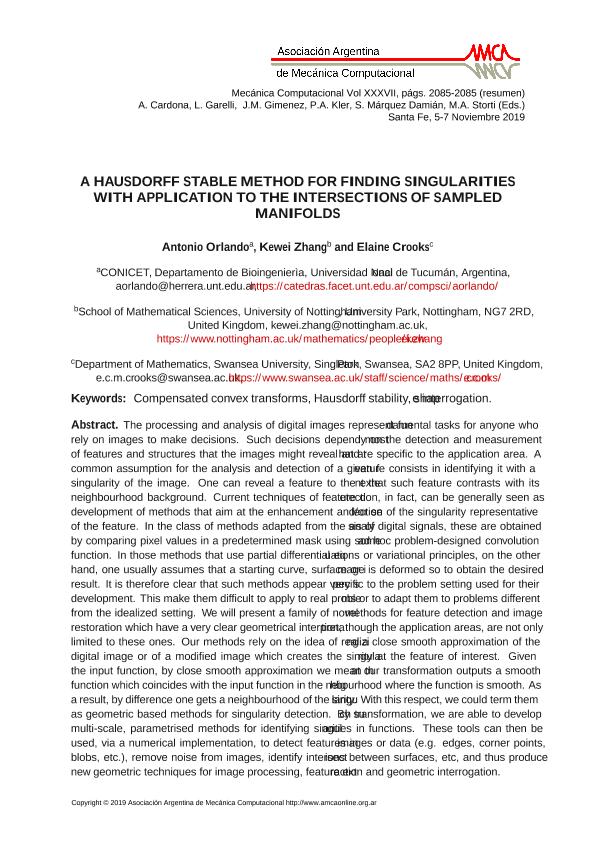Mostrar el registro sencillo del ítem
dc.contributor.author
Orlando, Antonio

dc.contributor.author
Zhang, Kewei
dc.contributor.author
Crooks, Elaine
dc.date.available
2023-07-05T19:19:57Z
dc.date.issued
2019
dc.identifier.citation
A Hausdorff Stable Method for Finding Singularities with Application to the Intersections of Sampled Manifolds; XXIV Congreso sobre Métodos Numéricos y sus Aplicaciones; Santa Fe; Argentina; 2019; 1-1
dc.identifier.issn
2591-3522
dc.identifier.uri
http://hdl.handle.net/11336/202537
dc.description.abstract
The processing and analysis of digital images represent fundamental tasks for anyone who relies on images to make decisions. Such decisions depend mostly on the detection and measurement of features and structures that the images might reveal and that are specific to the application area. A common assumption for the analysis and detection of a given feature consists in identifying it with a singularity of the image. One can reveal a feature to the extent that such feature contrasts with its neighbourhood background. Current techniques of feature detection, in fact, can be generally seen as a development of methods that aim at the enhancement and/or selection of the singularity representative of the feature. In the class of methods adapted from the analysis of digital signals, these are obtained by comparing pixel values in a predetermined mask using some ad hoc problem-designed convolution function. In those methods that use partial differential equations or variational principles, on the other hand, one usually assumes that a starting curve, surface or image is deformed so to obtain the desired result. It is therefore clear that such methods appear very specific to the problem setting used for their development. This makes them difficult to apply to real problems or to adapt them to problems different from the idealized setting. We will present a family of novel methods for feature detection and image restoration which have a very clear geometrical interpretation, though the application areas are not only limited to these ones. Our methods rely on the idea of realizing a close smooth approximation of the digital image or of a modified image which creates the singularity at the feature of interest. Given the input function, by close smooth approximation, we mean that our transformation outputs a smooth function that coincides with the input function in the neighbourhood where the function is smooth. As a result, by difference, one gets a neighbourhood of the singularity. With this respect, we could term them as geometric based methods for singularity detection. By such transformation, we are able to develop multi-scale, parametrised methods for identifying singularities in functions. These tools can then be used, via a numerical implementation, to detect features in images or data (e.g. edges, corner points, blobs, etc.), remove noise from images, identify intersections between surfaces, etc, and thus produce new geometric techniques for image processing, feature extraction and geometric interrogation.
dc.format
application/pdf
dc.language.iso
eng
dc.publisher
Asociación Argentina de Mecánica Computacional
dc.rights
info:eu-repo/semantics/openAccess
dc.rights.uri
https://creativecommons.org/licenses/by-nc-sa/2.5/ar/
dc.subject
HAUSDORFF STABILITY
dc.subject
SINGULARITY
dc.subject
COMPENSATED CONVEX TRASFORMS
dc.subject.classification
Matemática Aplicada

dc.subject.classification
Matemáticas

dc.subject.classification
CIENCIAS NATURALES Y EXACTAS

dc.title
A Hausdorff Stable Method for Finding Singularities with Application to the Intersections of Sampled Manifolds
dc.type
info:eu-repo/semantics/publishedVersion
dc.type
info:eu-repo/semantics/conferenceObject
dc.type
info:ar-repo/semantics/documento de conferencia
dc.date.updated
2022-11-09T17:53:31Z
dc.journal.volume
37
dc.journal.number
52
dc.journal.pagination
1-1
dc.journal.pais
Argentina

dc.description.fil
Fil: Orlando, Antonio. Consejo Nacional de Investigaciones Científicas y Técnicas. Centro Científico Tecnológico Conicet - Tucumán; Argentina. Universidad Nacional de Tucumán. Facultad de Ciencias Exactas y Tecnología. Departamento de Bioingeniería; Argentina
dc.description.fil
Fil: Zhang, Kewei. University of Nottingham; Estados Unidos
dc.description.fil
Fil: Crooks, Elaine. Swansea University; Reino Unido
dc.relation.alternativeid
info:eu-repo/semantics/altIdentifier/url/https://cimec.org.ar/ojs/index.php/mc/article/view/6044
dc.conicet.rol
Autor

dc.conicet.rol
Autor

dc.conicet.rol
Autor

dc.coverage
Internacional
dc.type.subtype
Congreso
dc.description.nombreEvento
XXIV Congreso sobre Métodos Numéricos y sus Aplicaciones
dc.date.evento
2019-11-05
dc.description.ciudadEvento
Santa Fe
dc.description.paisEvento
Argentina

dc.type.publicacion
Journal
dc.description.institucionOrganizadora
Asociación Argentina de Mecánica Computacional
dc.source.revista
Mecánica Computacional

dc.date.eventoHasta
2019-11-07
dc.type
Congreso
Archivos asociados
